Menu
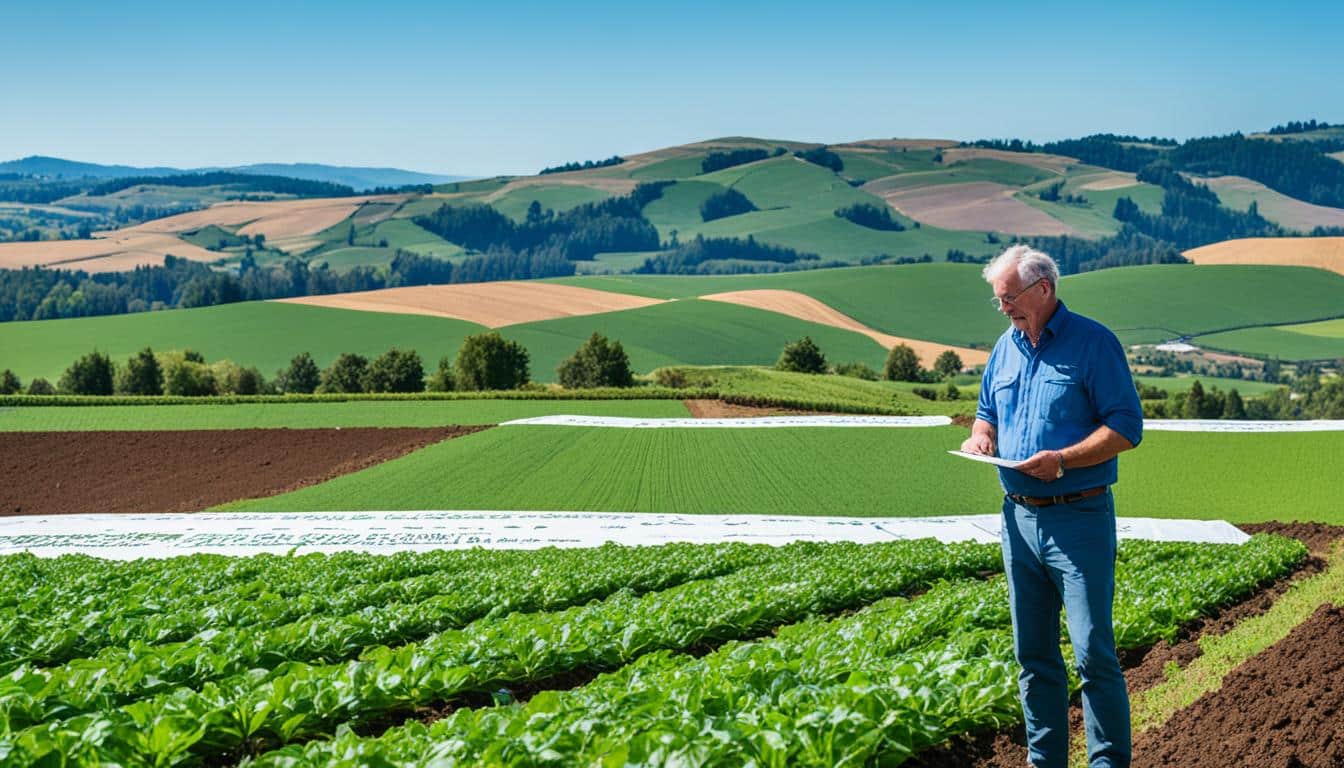
Did you know about half of the European Union is farmland? This links agriculture with the health of the earth. Good soil is key for farming success and to keep our planet healthy. Rules are in place to make sure farmers protect the soil they use.
The US also has a system to support those caring for their land. The Natural Resources Conservation Service (NRCS) helps with money and advice. This aid aims to make land better while keeping to the rules that protect our planet. It’s about making sure farms are sustainable and the earth stays fertile.
Soil health regulations aim to promote farming that’s kind to the earth. They encourage practices that keep soil fertile and productive. Many places, including states in the US and countries like Australia and Wales, have laws supporting these goals.
Farmers often find it hard to stay ahead because of various challenges. This includes not just money, but also physical work, and meeting rules. But, there’s help available from groups like the Natural Resources Conservation Service. They work to assist you in following soil health rules and take steps to protect the environment.
Different areas have their own ways of looking after the soil. For example, places like Vermont and Maine lead in making sure soils stay healthy. There are also local efforts, like those in Maine and California, where people work together to protect the land.
The Healthy Soils Program in California shows a great way forward. It has the HSP Incentives Program and Projects for showing what works to improve soil. These efforts get a lot of funding, which highlights the focus on better farming for the future.
Farming help also comes from national programmes. For example, the Environmental Quality Incentive Program got extra funding recently. This money helps farmers look after the soil better to reduce erosion and protect the environment.
There are also programmes for technical support and helping farmers prepare for climate change. They get a big budget because they’re so important for farming sustainably. These steps show a strong dedication to green farming.
In summary, soil health rules are key to better farming and a safer environment. Following these rules boosts farm productivity and resilience. This makes sure our land and farming stay good for the long run.
Soil health is key for farming. It keeps the land productive and able to bounce back from challenges. With 33% of soils worldwide in poor health, and 61% in the EU suffering too, good care is a must. This is done through better agricultural soil management.
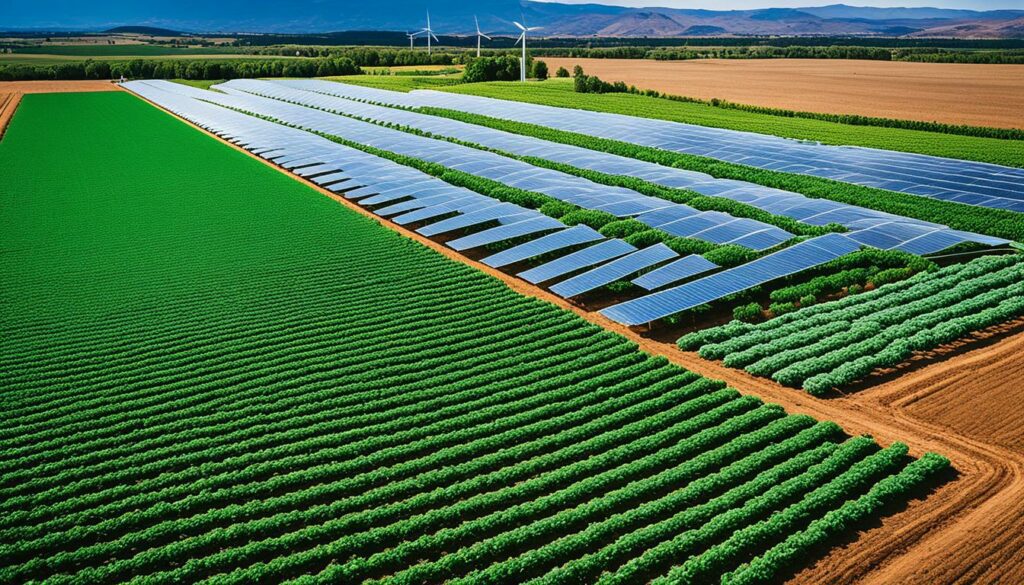
Healthy soil can soak up more water. This means less flooding and more water for plants when it’s dry. As a result, crops grow better and are stronger against tough times.
Looking after soil health also cuts down on erosion. This is when topsoil that’s full of nutrients gets washed or blown away. Practices like not tilling and planting cover crops keep soil in place. They also help keep nutrients where they’re needed.
Soil can recycle nutrients well if it’s cared for. This lessens the need for artificial fertilisers. It also means less harm to the environment from these chemicals. So, doing things that help soil bugs thrive is good for everyone.
Turning to regenerative agriculture helps a lot. It’s about using fewer chemicals, adding more organic matter, and being smart with water and nutrients. The IPBES warns that if we don’t step up, 90% of global soils could be in bad shape by 2050. By focusing on these advanced farming methods, we secure a better future for farming worldwide.
Government policies aim to help farms use methods that protect our soil long-term. They follow both state and national rules. The USDA gives out big rules, with local rules adding details for each area. Together, they help everyone in the US keep their soil healthy.
The USDA works on rules for all to save our soil well. With help from the Farm Bill, these guides keep farming sustainable. The 2018 Farm Bill, for example, started a plan to pay farmers to keep soil healthy. This makes sure everyone follows similar rules for farming to protect our soil.
In different areas, the rules for soil health can change. By February 10, 2024, 26 states had their own Healthy Soils laws. These states cover more than half of the farmland in the US. They also have almost two-thirds of the total US people. For example, Pennsylvania runs a Soil Health Program, following its own soil care rules.
States, like Kansas, support soil care through yearly budgets. Even without specific laws, they work hard for good soil. Nearly half of the US is farmable, showing how important soil health is. Local governments make sure these rules fit the needs of their lands and people.
By teaming up, USDA and local laws boost our land care. They tailor big rules to fit each area. This makes caring for our soil more effective and personal.
| State | Program | Acreage | Population |
|---|---|---|---|
| Pennsylvania | Soil Health Program | 7,032,626 | 12,801,989 |
| Kansas | Kansas Soil Health Initiative | 45,759,319 | 2,937,880 |
| California | Healthy Soils Program | 25,502,494 | 39,512,223 |
To follow soil health rules, farmers need smart plans. They can use USDA help and make good plans. These ways help keep the earth healthy and the farms running well for years.
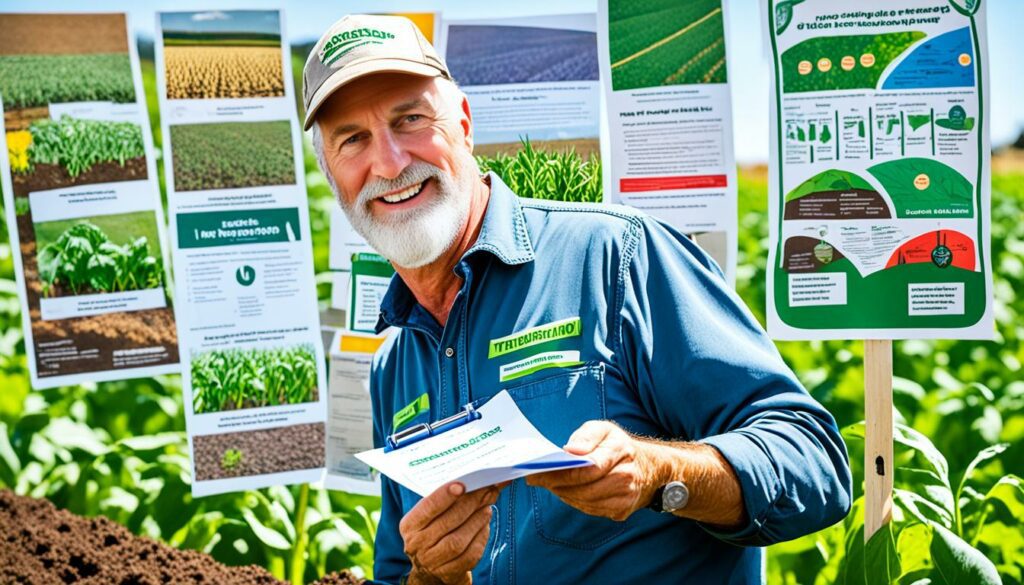
The USDA helps farmers a lot. Programs like the CSP and EQIP give money and advice.
CSP is big in the USA, covering 70 million acres. This shows it’s very important. EQIP helps pay for things and gives advice. It’s key for good farming.
Programs like ACEP also help by keeping working lands safe for the future. They work with long-term agreements.
Farmers must make good plans to meet soil rules. These plans should care for the soil and its quality.
Since 1985, US farms must protect wetlands and stop land erosion. It’s part of the law. Farmers check this with a USDA form. It’s important for good soil use and water protection.
The HSP in California is a good model. It encourages using good farming ways. In 2018, it asked for millions to fund 194 projects.
Another part, HSP Demonstration Projects, asked for money for 23 plans. These all aim to better soil health.
Following these steps is good for farming and the environment. Using USDA sources and making solid plans leads to sustainable farming. This way, farmers can care for their land and grow food for the future.
Using sustainable ways in farming is vital. It helps meet soil health and farming rules for the long haul. Approaches like less soil movement and growing various crops help make the soil rich and improve farming success.
Keeping soil disturbance low is key for a healthy ground. Methods like no-till and less turning over of soil keep erosion away. They also make spaces for animals and helpful bugs. These actions help keep carbon near the surface, protecting against carbon loss during ploughing.
Now, there are new methods to control weeds without ploughing. These include using other crops, tools, and ways to stop weed growth. The extra crops help keep soil and nutrients in place. They also make the soil better and bring more life into it. This is essential for good crop growing.
Swapping crops often does a lot of good for the earth. It makes the soil team with life, stops pests, and uses food better. Farmers prefer some crops, like beans, because they help add nitrogen to the soil. This nitrogen stays better than that from man-made sources.
Planting many types of crops at once makes fields healthier and more varied. This healthier mix does many jobs, making the farm stronger. For example, planting between rows helps the ground and brings in more good bugs.
| Practice | Benefits |
|---|---|
| No-till Cropping | Protects soil from erosion, improves habitat, increases soil carbon |
| Cover Crops | Controls erosion, reduces nutrient runoff, suppresses weeds |
| Crop Rotation | Enhances biodiversity, breaks pest cycles, optimises nutrient use |
| Interseeding | Improves soil health, promotes beneficial insects |
Doing these things well makes farms meet rules and make more money. It also helps keep the land and economy safe for those who come after.
To understand soil health, we look at its biological, physical, and chemical features. These features are key for managing soil in agriculture and meeting quality standards. Let’s dive into the main indicators.

The way soil feels, looks, and holds water is crucial for its health. Roots, fungi, and bacteria create soil lumps that help water flow and plants grow. Earthworms, by digging and moving, also make the soil better for plants.
Chemistry, like soil pH and the amount of salt, is vital for plant health. Too much salt can stop plants from getting enough water and food, hurting them. To fix this, farmers add things like manure to balance the soil.
Biological aspects are at the heart of good soil health. The amount of CO2 soil breathes out tells us about the life in it. This is a top marker for a soil’s well-being. Tests that look at CO2 levels help us understand how alive and healthy the soil is.
Soil health tests cost more than regular ones and results can vary between labs. Environmental conditions also affect the tests. To get a clear picture, we must all use the same methods. But, keeping our soil healthy is worth the effort. It’s the key to sustainable farming and meeting quality standards well.
Good soil management keeps our farms productive and safe for the environment. Following the right methods helps farmers keep their soil healthy. They can also make better crops. The main ideas here are to keep the soil covered and encourage more types of life in it.
Looking after the land helps the environment. It’s good for the soil to always have something on top of it. This way, the soil doesn’t get too bothered by people working the land. Farming without digging too much is great for the soil. It stops the land from washing away, keeps the water in, and helps bugs and birds find a home. Plants that cover the soil and special layers of straw or leaves are very helpful too. They stop the wind from taking the soil and keep water where it’s needed.
Having many different plants around is key to keeping farms going in a good way. Natural grasslands with lots of plants help the soil stay strong. This means there are more tiny creatures living in the soil, helping it in many ways. By growing different plants at different times, farmers can do great things for their land. They can stop the ground from running off, keep the soil full of good stuff, and keep it healthy. Some farmers keep lots of different plants between the trees or vines in their fields. This not only helps the soil but also gives a nice place for insects to live.
Farms that work closely with nature are doing better. They are finding that their soil is keeping more carbon, holding onto more water, and growing better food for animals to eat. By using these smart ways, farms can be good for nature and make money too.
| Principle | Strategy | Benefit |
|---|---|---|
| Maintaining Soil Cover |
|
|
| Increasing Biodiversity |
|
|
Learning about the benefits of soil health is vital for agricultural sustainability. Good soil increases crop yields and meets soil quality standards. A key study from the Rodale Institute showed organic plots produced a third more corn in drought thanks to better water retention. These methods improve yields and cut costs by 15% compared to non-organic farming.

From a money point of view, looking after the soil can save a lot. One study found that for every dollar spent on soil care, up to ten can be saved in reducing flood and river clean-up costs. Using natural fertilizers helps crops grow for the long term, supporting farming that can last.
The good done by healthy soil goes beyond money. Dung beetles, for one, can cut E. coli levels in food by 90%. This makes what we eat safer. Dung beetles also boost plant growth and help with recycling nutrients in grasslands. Soil health is good for both farming and the natural world.
“The relationship between healthy soil and productivity is clear. We better the soil, we improve the environment, and we feed the world,” notes a leading expert in soils.
Keeping to soil quality rules means we harm the Earth less. Using less synthetic nitrogen fertilisers, which emit greenhouse gases, is key. Every kilo of this fertiliser makes two kilos of CO2. This alone shows why working with the soil is important for the planet.
Too much of these fertilisers can cause health problems, even a dangerous illness for babies called blue baby syndrome. So, taking care of the soil is crucial for farming well and keeping people and the planet safe.
Dung beetles and other creatures show how important soil health is for life. They help spread seeds and fight off pests. This makes the area better for all living things. It’s a big part of keeping farming strong for the future.
Finally, farm runoff is bad for water quality. Phosphorus causes problems in fresh water, and nitrogen creates dead zones in the sea. Following strict soil rules and being kind to the land can help us avoid these issues. This way, we keep our water and land healthy for everyone coming after us.
| Aspect | Conventional Farming | Healthy Soil Practices |
|---|---|---|
| Corn Yields under Drought | Lower | One-third Higher |
| Overall Costs | 15% Higher | 15% Lower |
| Food Safety (E. coli Reduction) | Standard | Up to 90% Reduction |
| Synthetic Fertilizer Emissions | High | Reduced |
| Groundwater Contamination | Higher Risk | Lower Risk |
| Water Quality Impairments | Common | Reduced |
Following crop production guidelines is key to getting good yields. It also keeps the soil in good shape. By choosing the right crops and when to plant them, farmers help the earth. This way, they can grow crops well, without hurting the soil.
Choosing the best crops for an area is vital in farming. It helps keep the land safe and grows healthy food. Farmers pick crops that match the local climate and soil. This prevents problems like erosion and pests. Plants like legumes also help the soil by adding nutrients to it. Growing a variety of crops makes the land stronger and more diverse, which is good for the future of farming.
When crops are planted matters a lot. Farmers should plant when the weather is good and natural cycles support growth. For example, in places with winter rain, planting certain cover crops helps the land. These crops keep the soil from washing away and improve its water-holding ability. These methods are part of keeping the soil healthy and helping farms work better and with less harm.
Cover crops and no-till farming are great for the soil. They prevent erosion and make the soil healthier. Cover crops also help stop nutrients from leaving the fields, stop weeds, and make the area more diverse. No-till farming protects the soil from getting too hard and helps wildlife live on farms.
| Agriculture Practice | Benefits |
|---|---|
| Cover Crops | Reduce erosion, improve soil fertility, and increase biodiversity |
| No-Till Systems | Protect against erosion, reduce compaction, and improve wildlife habitat |
| Leguminous Crops | Support nitrogen-fixing rhizobia, enhance soil fertility |
| Multispecies Crop Mixes | Enhance field-scale diversity and ecological functions |
Environmental protection in agriculture is key for healthy soil. It is critical for sustainable farm methods. Following soil fertility regulations closely helps with caring for the Earth. It also makes farms more able to withstand challenges.
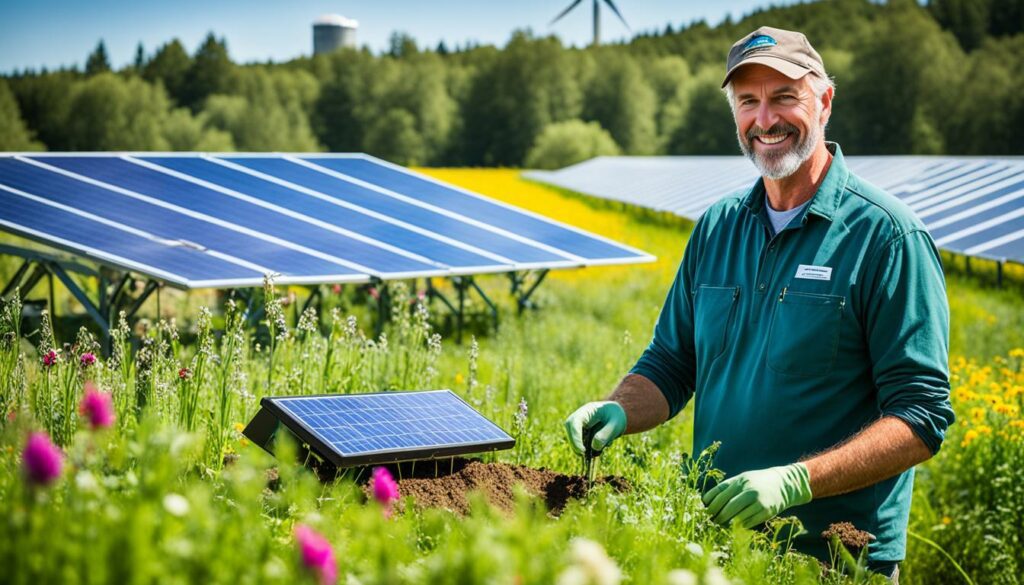
Cover crops are vital for sustainable agriculture. They lessen erosion, cut down nutrient runoff, fight weeds, and boost soil nutrients. They also make the land full of life. Legumes, like beans, in these crops, help by fixing nitrogen in soil. This is a slow, steady method to keep the soil rich.
Mixing different types of plants in cover crops improves biodiversity on a large scale. Doing this between regular crops can attract more songbirds and helpful bugs. These creatures play a big role in keeping pests in check and pollinating plants.
Terraces and windbreaks are great for the land. They have been helping with farming for many years in parts of Europe and Asia. In the USA, windbreaks reduce strong winds, protecting crops. Also, not ploughing the land before planting can cut down on greenhouse gases. This means less harm to the environment.
The government’s help is key in making farms greener. The Inflation Reduction Act of 2022 is a perfect example. It invested a lot of money in environmental protection in agriculture. For instance, it gave billions to help in quality farming and nature conservation.
There’s also the soilSHOP idea. It lets people check their soil for lead at no cost. These actions show a big push, about $19.5 billion, towards eco-friendly farming. This effort helps both the land and farmers who depend on it.
Finally, perennial crop farmers can keep the land between their plants full of life. This is good for the environment. It helps keep bad bugs away and supports a healthy ecosystem. But, it needs careful attention to avoid harming the environment. Following soil fertility regulations means aiming for a rich, diverse land.
New methods are changing how we care for soil, leading to a brighter future in farming. The Innovative Practices for Soil Health Act of 2024 is a big step towards better farming. It focuses on helping with longer-term crops and trees. By using these recent techniques, farmers can take better care of their land and follow new rules easily.
This Act ramps up help for farmers through advice and financial support. It’s aimed at setting up these longer-term farming methods more easily. The USDA will work with farmers to make sure this help fits their needs. The goal is to make the latest soil techniques work well for everyone.
Now, longer-term crops are important for both EQIP and CSP programs. These are part of a bigger plan to help farmers look after their land. This makes it easier for farmers to know how to grow their crops better and still follow the rules.
The Act also gives extra money to farmers who grow crops for many years. This support helps with special farming methods like planting trees with crops or growing things without chemicals. The money will also help farmers test their soil health. This way, farmers can check if the new methods are working well and if they follow the rules.
Many different people, including Tribes, can now get special training on farming methods. This includes growing things next to trees, finding ways to reduce pollution, and changing to organic farming. Making it simpler for these people to be trained means better farming and following the rules.
To keep improving our farming, we’re setting up a big place for research and learning about farming with trees. This is backed by $40 million from the USDA for new farming projects. It shows a strong aim to better care for our land using new and proven ways.
There’s also a lot of money set aside to test new farming methods right on the farm and to help smaller farmers. For those who don’t usually get as much help, there’s special money set aside. Plus, a huge $70 million is going towards projects that reach out to everyone. It means more people can join in and get the benefits of these new farming ideas.
If farmers want to make more money, they should look closely at the costs and benefits of good soil care. Things like not tilling the soil, using less tillage, planting cover crops, and rotating crops can seem hard. But there’s help. The R-SHEC Tool makes it easier to check if these methods are worth it.
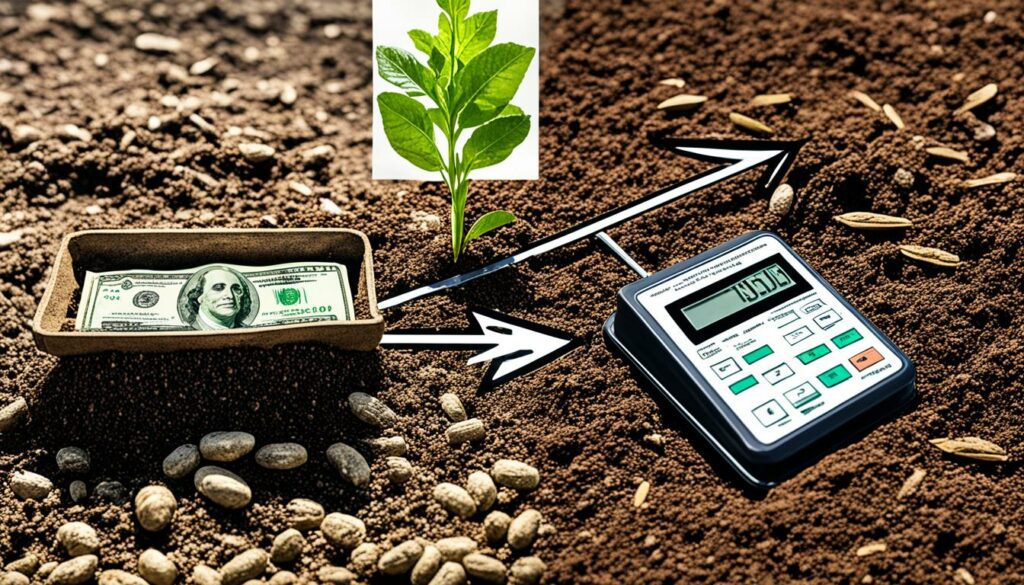
The R-SHEC Tool is for those who grow rows of plants or almonds. It shows them the money side of taking care of the soil. Such information can be the key to convincing farmers to think long-term about their fields. This project is supported by the USDA and its grants, including the Conservation Innovation Grant from 2018 to 2021. It shows help is available for improving how people manage their land.
There are four big ways to see if taking care of the soil pays off for farmers. These methods are well-documented, thanks to studies by AFT and support from the Natural Resources Conservation Service. The AFT studies are full of examples. New land caretakers can learn a lot from these. If farmers need help, they can ask their local NRCS officers, SWCD staff, or contact AFT for advice.
Different farms use soil health practices in various ways. For example, not tilling is done on about a third of lands. Cover crops are used by almost 9% of farms and about 3% of the land is covered by them. Other practices, like using mulch, are seen on 27.5% of lands. These methods follow soil care rules and help farms make more profit. They save money and make crops better.
The government has also pushed for these good soil practices. Between 2005 to 2013, spending on cover crops by the NRCS went from $5 million to over $50 million a year. Another program, the CSP, started in 2008, also supports good land care. The government’s big help shows its strong desire for farming that’s good for the earth and farm wallets.
| Practice | Adoption Rate |
|---|---|
| No-Till | 34.6% |
| Cover Crops | 8.6% (Farms), 2.9% (Cropland Acres) |
| Conservation Tillage (Mulch/Ridge Till) | 27.5% |
Using the soil health methods mentioned earlier doesn’t just help nature. It also makes money. With help from the USDA and NRCS, as well as tools like the R-SHEC Calculator, farmers can do even better. They can grow more and earn more from their land.
Farmers often look to detailed case studies for soil health advice. These studies show how good farming practices help both the planet and their farms. They offer a map for improving how we manage our land and crops.
Terracing has kept crops growing well in Europe and Asia for ages. It helps stop erosion and makes the land last longer. In the U.S., windbreaks protect fields from strong winds, saving the topsoil.
No-till farming is great for stopping soil erosion and welcoming wildlife. But, sometimes, turning over the soil once can be good for certain microbes. Cover crops, like triticale and cereal rye, are also heroes. They stop erosion and make the soil better by adding nutrients.
Rolling down crops and planting different things together also do a lot of good. They help nature in many ways. Then there are plants like peas that add important nutrients to the soil. These techniques make both the land and the pocketbook healthier.
The American Farmland Trust (AFT) shares case studies from various American states. These stories tell us how to make soil better while also making good money. They teach farmers smart ways to take care of their land. Experts like Justin Bodell and Brian Brandt share their wisdom in these studies. They are a treasure chest of knowledge for anyone in farming. Reading these cases can help farmers do better for their land and business.
Soil health regulations aim to boost sustainable farming. They encourage practices that keep or boost soil productivity. This way, they help reduce erosion and make soil better at holding water. They also help keep nutrients moving, which keeps farmland productive over time.
The USDA, mainly through the NRCS, provides help to farmers and ranchers. They offer technical and financial aid. Local USDA offices can work with farmers to make custom management plans. These plans help improve the land while sticking to the regulations.
The government, through the USDA and local laws, sets guidelines for soil care. These regulations help farmers across the nation. They ensure everyone follows practices that keep soil rich and productive.
Practices like reducing how much we disturb soil and changing the types of crops we grow are key. These steps are important for a strong soil ecosystem. They make the soil more resistant and productive. This leads to a farming that’s good for the long term and also makes money.
We can tell how healthy soil is by looking at its physical, chemical, and biological parts. These measurements help farmers see how their soil is doing. They also help in picking soil-friendly practices.
Keeping the soil covered and varied is vital for good soil health. This approach lowers erosion and keeps nutrients nearby, helping the soil to be rich and ready for plants. It also creates homes for helpful creatures, making a balanced system.
Finding the balance in soil leads to more food, better farming against the weather, and rich wildlife areas. Healthy soil is the foundation of successful and lasting farming, and protects our environment for the future.
Guidelines on what to plant and when help in using the soil well. They give farmers the right knowledge to grow good crops without harming the land. This ties in with the goals of keeping the soil healthy for the future.
Looking after the soil’s health is key to protecting our environment. By following soil care rules, we safeguard our nature and keep farming steady. This approach supports keeping our land safe and in good shape.
New tech provides tools to look after the soil better. These help in keeping up with rules more easily and make the soil more fertile. This supports greener farming practices for the future.
Farmers can figure out if soil health practices are worth it by comparing costs with the benefits. This helps see if following the rules will pay off in the long run. It guides decisions on using their land well.
Yes, learning from successful soil projects can give smart ideas to farmers. These success stories show practical ways to do well under the soil health rules. They’re a source of good advice for farmers aiming to improve their land.